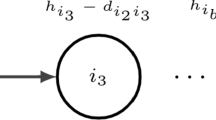Abstract
We consider a two-stage defender-attacker game that takes place on a network, in which the attacker seeks to take control over (or “influence”) as many nodes as possible. The defender acts first in this game by protecting a subset of nodes that cannot be influenced by the attacker. With full knowledge of the defender’s action, the attacker can then influence an initial subset of unprotected nodes. The influence then spreads over a finite number of time stages, where an uninfluenced node becomes influenced at time t if a threshold number of its neighbors are influenced at time t−1. The attacker’s objective is to maximize the weighted number of nodes that are influenced over the time horizon, where the weights depend both on the node and on the time at which that is influenced. This defender-attacker game is especially difficult to optimize, because the attacker’s problem itself is NP-hard, which precludes a standard inner-dualization approach that is common in many interdiction studies. We provide three models for solving the attacker’s problem, and develop a tailored cutting-plane algorithm for solving the defender’s problem. We then demonstrate the computational efficacy of our proposed algorithms on a set of randomly generated instances.





Similar content being viewed by others
References
Barabási, A., Albert, R.: Emergence of scaling in random networks. Science 286, 509–512 (1999)
Blum, J., Ding, M., Thaeler, A., Cheng, X.: Connected dominating set in sensor networks and MANETs. In: Du, D., Pardalos, P.M. (eds.) Handbook of Combinatorial Optimization Supplement Volume B, pp. 329–369. Springer, Berlin (2005)
Brown, G.G., Carlyle, W.M., Salmerón, J., Wood, K.: Analyzing the vulnerability of critical infrastructure to attack and planning defenses. In: Greenberg, H.J., Smith, J.C. (eds.) Tutorials in Operations Research: Emerging Theory, Methods, and Applications, pp. 102–123. INFORMS, Hanover (2005)
Brown, G.G., Carlyle, W.M., Salmerón, J., Wood, K.: Defending critical infrastructure. Interfaces 36(6), 530–544 (2006)
Budak, C., Agrawal, D., El Abbadi, A.: Limiting the spread of misinformation in social networks. In: Proceedings of the Twentieth International Conference on World Wide Web. ACM, New York (2011)
Chen, N.: On the approximability of influence in social networks. SIAM J. Discrete Math. 23(3), 1400–1415 (2009)
Chung, F.R.K., Lu, L.: Complex Graphs and Networks. Am. Math. Soc., Providence (2006)
Dinh, T.N., Nguyen, D.T., Thai, M.T.: Cheap, easy, and massively effective viral marketing in social networks: truth or fiction? In: Proceedings of the Twenty Third ACM Conference on Hypertext and Social Media, pp. 165–174. ACM, New York (2012)
Garey, M.R., Johnson, D.S.: Computers and Intractability: A Guide to the Theory of NP-Completeness. Freeman, Princeton (1979)
Goldenberg, J., Libai, B., Muller, E.: Talk of the network: a complex systems look at the underlying process of word-of-mouth. Mark. Lett. 12, 211–223 (2001)
Guo, J., Niedermeier, R., Raible, D.: Improved algorithms and complexity results for power domination in graphs. In: Liskiewicz, M., Reischuk, R. (eds.) Fundamentals of Computation Theory. Lecture Notes in Computer Science, vol. 3623, pp. 172–184. Springer, Berlin (2005)
Kempe, D., Kleinberg, J., Tardos, E.: Maximizing the spread of influence through a social network. In: Proceedings of the Ninth ACM SIGKDD International Conference on Knowledge Discovery and Data Mining, pp. 137–146. ACM, New York (2003)
Leskovec, J., Krause, A., Guestrin, C., Faloutsos, C., VanBriesen, J., Glance, N.: Cost-effective outbreak detection in networks. In: Proceedings of the Thirteenth ACM SIGKDD International Conference on Knowledge Discovery and Data Mining, pp. 420–429. ACM, New York (2007)
Nemhauser, G.L., Wolsey, L.A., Fisher, M.L.: An analysis of the approximations for maximizing submodular set functions. Math. Program. 14, 265–294 (1978)
Nguyen, N.P., Yan, G., Thai, M.T., Eidenbenz, S.: Containment of misinformation spread in online social networks. In: Proceedings of the Fourth ACM Web Science (2012)
Nicol, D., Liljenstam, M.: Models and analysis of active worm defense. In: Proceedings of the Third International Workshop on Mathematical Models, Architectures and Protocols for Computer Network Security (MMM-ACNS), pp. 38–53 (2005)
Shen, S.: Domination problems. In: Cochran, J. (ed.) Wiley Encyclopedia of Operations Research and Management Science, pp. 1470–1488. Wiley, Hoboken (2011)
Shen, S., Smith, J.C., Goli, R.: Exact interdiction models and algorithms for disconnecting networks via node deletions. Discrete Optim. 9(3), 172–188 (2012)
Shen, Y., Dinh, T.N., Zhang, H., Thai, M.T.: Interest-matching information propagation in online social networks. In: ACM International Conference on Information and Knowledge Management (CIKM) (2012)
Smith, J.C.: Basic interdiction models. In: Cochran, J. (ed.) Wiley Encyclopedia of Operations Research and Management Science, pp. 323–330. Wiley, Hoboken (2011)
Smith, J.C., Lim, C.: Algorithms for network interdiction and fortification games. In: Migdalas, A., Pardalos, P.M., Pitsoulis, L., Chinchuluun, A. (eds.) Pareto Optimality, Game Theory and Equilibria. Nonconvex Optimization and Its Applications Series, pp. 609–644. Springer, New York (2008)
Tanachaiwiwat, S., Helmy, A.: Encounter-based worms: analysis and defense. Ad Hoc Netw. 7(7), 1414–1430 (2009)
von Stackelberg, H.: The Theory of the Market Economy. William Hodge & Co., London (1952)
Wood, R.K.: Deterministic network interdiction. Math. Comput. Model. 17(2), 1–18 (1993)
Wu, J., Cardei, M., Dai, F., Yang, S.: Extended dominating set and its applications in ad hoc networks using cooperative communication. IEEE Trans. Parallel Distrib. Syst. 17(8), 851–864 (2006)
Zhao, M., Kang, L., Chang, G.J.: Power domination in graphs. Discrete Math. 306(15), 1812–1816 (2006)
Acknowledgements
The authors are grateful for the comments of two anonymous referees, whose remarks led to an improved version of this paper. The authors also gratefully acknowledge the support of the “National Science Foundation under grants CMMI-1100765 and CAREER 0953284”, the Defense Threat Reduction Agency under grant HDTRA-10-01-0050, the Air Force Office of Scientific Research under grant FA9550-12-1-0353, and the Office of Naval Research under grant N000141310036.
Author information
Authors and Affiliations
Corresponding author
Rights and permissions
About this article
Cite this article
Hemmati, M., Cole Smith, J. & Thai, M.T. A cutting-plane algorithm for solving a weighted influence interdiction problem. Comput Optim Appl 57, 71–104 (2014). https://doi.org/10.1007/s10589-013-9589-9
Received:
Published:
Issue Date:
DOI: https://doi.org/10.1007/s10589-013-9589-9




